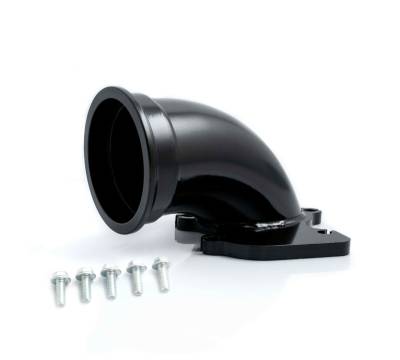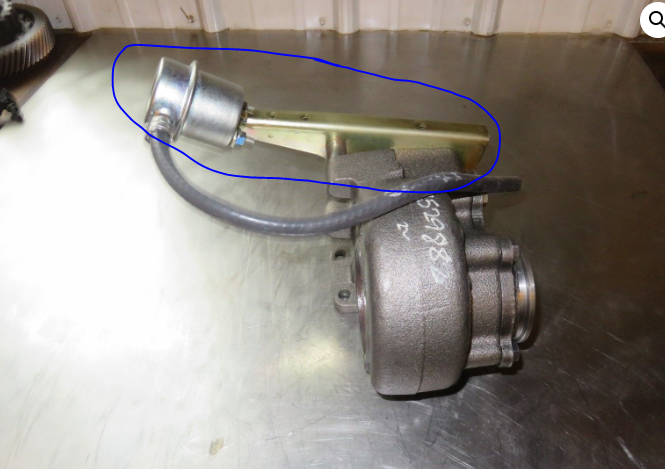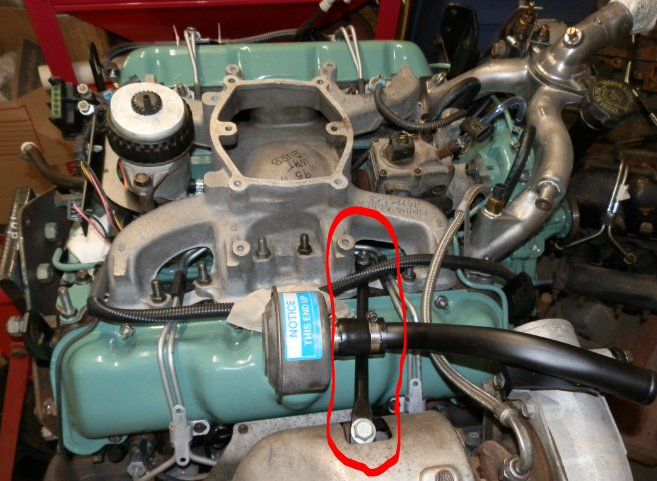Navigation
Install the app
How to install the app on iOS
Follow along with the video below to see how to install our site as a web app on your home screen.
Note: This feature may not be available in some browsers.
More options
-
Welcome to The Truck Stop! We see you haven't REGISTERED yet.
Your truck knowledge is missing!
- Registration is FREE , all we need is your birthday and email. (We don't share ANY data with ANYONE)
- We have tons of knowledge here for your diesel truck!
- Post your own topics and reply to existing threads to help others out!
- NO ADS! The site is fully functional and ad free!
Problems registering? Click here to contact us!
Already registered, but need a PASSWORD RESET? CLICK HERE TO RESET YOUR PASSWORD!
You are using an out of date browser. It may not display this or other websites correctly.
You should upgrade or use an alternative browser.
You should upgrade or use an alternative browser.
Turbo rebuild, replace, upgrade
- Thread starter SnowDrift
- Start date
MrMarty51
Well-Known Member
My truck is a 2000. I was supplied with an ATeam Turbo so it has no waste gate.Does this part just get removed if I am using a manual wastegate setup? This is from the link in Post #12
View attachment 80976
I left the vacuum pump in place and removed the waste gate actuator and just plugged the vacuum tube to keep from tripping on the SES lamp.
Someday I’ll find a spare PCM and get it programmed for this turbo then eliminate the vacuum pump.
If I keep this truck for very much longer.
Husker6.5
135' diagonal 16:9HD, 25KW sound!
Yup. The mechanical (spring loaded) wastegate assembly replaces the boost or vacuum actuated wastegate assembly. You then either plug the vacuum line or remove the vacuum pump or plug the intake manifold boost source depending on the type of actuator assembly.Does this part just get removed if I am using a manual wastegate setup? This is from the link in Post #12
View attachment 80976
Husker6.5
135' diagonal 16:9HD, 25KW sound!
Now, there are pros and cons to using a straight mechanically-actuated wastegate (like what is usually used to replace the GM-X vacuum-actuated wastegate) - where exhaust drive back pressure pushes against the exhaust wastegate valve until the pressure is greater than the spring holding the wastegate valve shut and allows exhaust gasses to bypass the drive turbine wheel to regulate intake manifold pressure.
Versus an intake manifold pressure-actuated wastegate where an excess build up of intake charge pressure pushes against a spring loaded diaphragm that opens the wastegate to relieve exhaust drive turbine flow and slow the drive turbine down and thus reduces the intake charge pressure back down to below the spring's rating and a safe intake pressure. That style is usually more responsive to sudden, more damaging increases over intake charge pressures than a straight spring-loaded mechanical wastegate actuators that use exhaust drive pressure to control the intake charge pressure.
That's why Cummins used Holeset turbos that used an intake manifold charge pressure actuated wastegate.
You could also go with a non-wastegated turbo - like an ATT - with a manifold pop-off valve to control dangerous over pressures in the intake charge that open up at a set pressure, sorta like the relief valve on an old-style pressure cooker.
Versus an intake manifold pressure-actuated wastegate where an excess build up of intake charge pressure pushes against a spring loaded diaphragm that opens the wastegate to relieve exhaust drive turbine flow and slow the drive turbine down and thus reduces the intake charge pressure back down to below the spring's rating and a safe intake pressure. That style is usually more responsive to sudden, more damaging increases over intake charge pressures than a straight spring-loaded mechanical wastegate actuators that use exhaust drive pressure to control the intake charge pressure.
That's why Cummins used Holeset turbos that used an intake manifold charge pressure actuated wastegate.
You could also go with a non-wastegated turbo - like an ATT - with a manifold pop-off valve to control dangerous over pressures in the intake charge that open up at a set pressure, sorta like the relief valve on an old-style pressure cooker.
SnowDrift
Ultra Conservative. ULTRA!
I'm back to considering my options for the turbo.turbine wheel/shaft - https://www.ebay.com/itm/134012750986?hash=item1f33c84c8a:g:NmIAAOSweElh-por&amdata=enc:AQAHAAAAoJtetSndaQAxG2pncYc4p6qjZxA01NG0Qul+e2b0Cc2qLTylX98b5t3cNt0rd8zrxXKj9z1TcrGKrJRLRkn5O34foweGIazcso7cVbB44Ydbuef/XNh+WfN6TYEL0wJnIeEcqmd13ulMLXl47Ck9M1f/MZMN+LwIuxhBNUAMhNAzHPrCU/TP0Chuif72O7gHn2OR6bdMIbZqNgChsbx9VLc=|tkp:Bk9SR8aahcCEYQ
14cm turbine housing - https://ekgdiesel.com/product/hx35-holset-hx35w-turbo-exhaust-housing-14cm-t3-flang3/
hx40 pro com wheel - http://turbolabofamerica.com/60mm-x-86mm-hx40-pro-billet-compressor-wheel/
comp cover - https://www.speedingparts.com/p/tur...ger/holset-super-hx40-compressor-housing.html
The center section is the same for both 35 & 40.
Turbine wheel/shaft still available.
14cm housing - link no longer yields a result
hx40 wheel still shows a part, but I don't see much when I go to "buy now"
compressor cover still available
I did find this while I was looking around for the 14cm turbine housing:

Holset Genuine Holset HX35 & 12cm exh housing
Genuine Holset HX35 & 14cm waste gated exh housing. Good as a single turbo or as a 4bt primary in twins with a 44mm hx30w
It looks like this kit is still available, originally posted by @Twisted Steel Performance
High Tech Turbo HX35/40 Hybrid Turbocharger - 1994-2002 Dodge Cummins 2nd Gen. | Thoroughbred Diesel
High Tech Turbo HX35/40 Hybrid Turbocharger - 1994-2002 Dodge Cummins 2nd Gen. is now available at Thoroughbred Diesel.
www.thoroughbreddiesel.com
Available here....
If you are planning to go the DB2 route a 14cm turbine would be best.
A holset hx35 is a bit small on the compressor side ..
I don't see anything on turbo lab's site or fleabay right now either.
If you are planning to go the DB2 route a 14cm turbine would be best.
A holset hx35 is a bit small on the compressor side ..
I don't see anything on turbo lab's site or fleabay right now either.
SnowDrift
Ultra Conservative. ULTRA!
What is your core size on your intercooler @DieselAmateur ?
DieselAmateur
She ain't revved 'til the rods are thrown...
This is the intercooler I purchased https://www.ebay.com/itm/314019994048
Core size is 23" wide by 11.75" tall and 3" thick. Overall width according to the pictures between inlet and outlet is 30.75"
it is definitely the largest cooler that will fit between the frame rails
Core size is 23" wide by 11.75" tall and 3" thick. Overall width according to the pictures between inlet and outlet is 30.75"
it is definitely the largest cooler that will fit between the frame rails
The linked cooler has the same overall size as the one I have used, the only difference is the core size, mine is 19.5" vs 23", negleable difference.
SnowDrift
Ultra Conservative. ULTRA!
better price than the one I was considering. 31" overall width. 23" core vs. 24" core.
SnowDrift
Ultra Conservative. ULTRA!
My plan is to switch to a DB2 setup eventually. I'm looking for towing ability and I'm also partial to the whistle. I like the sound at idle and also when I'm going down the road. I'd be anxiously awaiting for people to give a double take looking at an old '95 that sounded like it was good and strong.
Looking at the parts again for a turbo, the total of the 4 parts is in the $600-700 range. Knowing nothing about turbos, is that all the components or are there more parts and those are just the major ones?
Looking at the parts again for a turbo, the total of the 4 parts is in the $600-700 range. Knowing nothing about turbos, is that all the components or are there more parts and those are just the major ones?
SnowDrift
Ultra Conservative. ULTRA!
Husker6.5
135' diagonal 16:9HD, 25KW sound!
If there's a threaded boss on the new turbo to bolt a stability bracket to, you either modify that bracket or fabricate a new one to fit. It's there to basically dampen/eliminate vibration of the turbo because it's hanging way out there on the exhaust manifold and shearing/loosening either turbo mounting studs or exhaust manifold bolts because of that chunk of iron and aluminum's mass moving around.what happens with this bracket when the Holset or another turbo is used?
View attachment 85459
DieselAmateur
She ain't revved 'til the rods are thrown...
I never modified/ repurposed the bracket for the 2 different turbos I've used. I can see why making another brace could be helpful as Husker described but I just tossed it and forgot. I know lots of other folks have used other turbos on this engine, would be curious to know whether they made another brace or not. I only have 35k on my rig with an upgraded turbo and no extra brace and no issue to report so far
Husker6.5
135' diagonal 16:9HD, 25KW sound!
Hey, I'm just stating what it's there for, and the GM engineers decided that it was needed for that reason. Every other turbo besides the GM-x series that have been used on these motors were designed to be used in other applications/motors/mounting where a stabilizing/vibration brace wasn't necessary.I never modified/ repurposed the bracket for the 2 different turbos I've used. I can see why making another brace could be helpful as Husker described but I just tossed it and forgot. I know lots of other folks have used other turbos on this engine, would be curious to know whether they made another brace or not. I only have 35k on my rig with an upgraded turbo and no extra brace and no issue to report so far
SnowDrift
Ultra Conservative. ULTRA!
Makes sense. Lots of cantilever load on the "pivot bolts" (exhaust manifold bolts).
SnowDrift
Ultra Conservative. ULTRA!
I found this adapter for this turbo swap.

 rudysdiesel.com
rudysdiesel.com
What other parts will be necessary? Supply hose connector? Drain adapter of some sort?
I have a 2-1/2" downpipe I believe on the Banks Stinger exhaust I have currently.

Rudy's V-Band Holset HX35 Turbo Direct Pipe Adapter For GM 6.5L Turbo Diesel
Rudy's V-Band Holset HX35 Turbo Direct Pipe Adapter For GM 6.5L Turbo Diesel
What other parts will be necessary? Supply hose connector? Drain adapter of some sort?
I have a 2-1/2" downpipe I believe on the Banks Stinger exhaust I have currently.
I have a 2-1/2" downpipe I believe on the Banks Stinger exhaust I have currently.
You aren't using the stock manifolds ? Me thinks this is for a stock setup swapping only a turbo...
dbrannon79
I'm getting there!
If you have a prime account, this is free shipping and is about $10 cheaper. I've had one in my wish list for a good while but have stayed with the GMx turbo.
As an Amazon Associate we earn from qualifying purchases.
SnowDrift
Ultra Conservative. ULTRA!
I am indeed using stock manifolds. The Banks Stinger system I mentioned is the downpipe and rearward, not the manifolds.You aren't using the stock manifolds ? Me thinks this is for a stock setup swapping only a turbo...


